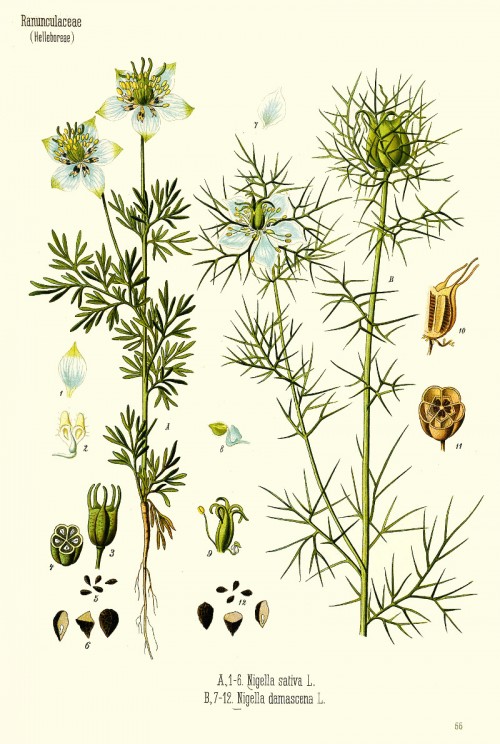Benutzer-Werkzeuge
Dies ist eine alte Version des Dokuments!
Nigella sativa L. - Ranunculaceae - black caraway, black cumin, Roman coriander, nutmeg flower, Echter Schwarzkümmel
Annual herb, 20-30cm tall, native to West Asia (Turkey, Iran); naturalized in the Mediterranean region, cultivated elsewhere.
„Seeds of Nigella sativa have a pungent bitter taste and smell. It is used primarily in confectionery and liquors.“
http://plantgenera.org/species.php?id_species=701431
„The chemical composition of the extracted [petrolether] fixed oil (total fatty acid composition) and volatile oil [hydrodistilled from the petrol ether extract] of Nigella sativa L. seeds grown in Iran were determined by GC and GC/MS. Eight fatty acids (99.5%) and thirty- two compounds (86.7%) have been identified in the fixed and volatile oils, respectively. The main fatty acids of the fixed oil were linoleic acid (55.6%), oleic acid (23.4%), and palmitic acid (12.5%). The major compounds of the volatile oil were trans-anethole (38.3%), p-cymene (14.8%), limonene (4.3%), and carvone (4.0%).“ The thymoquinone content was 0.6%.
[Chemical composition of the fixed and volatile oils of Nigella sativa L. from Iran. Nickavar, B., Mojab, F., Javidnia, K., Amoli, M. A. R., Zeitschrift Fur Naturforschung C, 5Vol.8(9/10), 2003, 629-631] http://www.znaturforsch.com/ac/v58c/s58c0629.pdf?origin=publication_detail
„The major saponin in the defatted seeds of N. sativa is the glycoside α-hederin or Helixin or melanthin which on acid hydrolysis releases its sugar rhamnose / arabinose and gives the aglycone hederagenin (or melanthigenin) or caulosapogenin.“
[The black seed Nigella sativa Linnaeus-A mine for multi cures: a plea for urgent clinical evaluation of its volatile oil., El-Tahir, K.E.D.H., Bakeet, D.M., Journal of Taibah University Medical Sciences, 1(1), 2006, 1-19]
http://www.sciencedirect.com/science/article/pii/S1658361206700038
Gram negative bacteria like Haemophilus influenza, Klebsiella pnemoniae, and Proteus vulgaris were highly sensitive against the essential oil of N.sativa. Main constituents of the oil analysed by GC-MS was trans-anethole (27.1%), thymoquinone (11.8%), p-cymene (9.0%), longifolene (5.7%), limonene (4.3%), carvacrol (3.7%), 2(1H)-naphthalenone (2.6%), α-thujene (2.4%) and carvone (2.0%). Minor constituents were estragole (1.9%), myristicin (1.4%), nerole (1.3), fenchone (1.1%), and sabinene (1.4%) e.g.
[GC-MS analysis of Nigella sativa seeds and antimicrobial activity of its volatile oil., Gerige, S.J., Gerige, M.K.Y., Rao, M., Brazilian Archives of Biology and Technology, Vol.52(5), 2009, 1189-1192]
http://www.scielo.br/pdf/babt/v52n5/v52n5a16.pdf
„Hydroponically cultivated Nigella sativa L. plants treated with methyl jasmonate (MeJA) showed a twelve-fold increase in levels of the monodesmosidic triterpene saponins α-hederin and kalopanaxsaponin I (KsI) in the leaves. We will demonstrate that these two saponins accounted for approximately 10% of the dry plant matter, of which 93% was KsI and 7% α-hederin. To address the molecular basis of saponin induction by MeJA, we cloned and characterized the β-amyrin synthase gene (NsβAS1) encoding one of the key enzymes in triterpene saponin biosynthesis. As expected, NsβAS1 transcription was induced by MeJA and led to the production of β-amyrin when over-expressed in yeast.“
[Methyl jasmonate induced accumulation of kalopanaxsaponin I in Nigella sativa., Scholz, M., Lipinski, M., Leupold, M., Luftmann, H., Harig, L., Ofir, R., Müller, K.J., Phytochemistry, Vol.70(4), 2009, 517-522]
„The Canon of Medicine, refers to Nigella as the seed that stimulates the body's energy and helps recovery from fatigue and dispiritedness. It is also included in the list of natural drugs of 'Tibb-e-Nabavi', or „Medicine of the Prophet (Muhammad)“, according to the tradition „hold onto the use of the black seeds for healing all diseases. In the Unani Tibb system of medicine, N.sativa is regarded as a valuable remedy for a number of diseases. In the Indian system of medicine, the seeds are used as astringent, bitter, stimulant, diuretic, emmenagogue, anthelmintic, jaundice, intermittent fever, dyspepsia, paralysis, piles and skin diseases…“
[Pharmacognosy and pharmacology of Nigella sativa-A review., Rajsekhar, S., Kuldeep, B., Int Res J Pharm, Vol.2(11), 2011, 36-9]
http://www.irjponline.com/admin/php/uploads/673_pdf.pdf
„The constituents of Nigella sativa modulate the immune system… Data from 40 female RA patients diagnosed according to the 2010 ACR/EULAR were analysed and discussed. The patients took two placebo (starch filled) capsules daily for 1 month. This was followed by a month of Nigella sativa oil capsules 500mg twice/day. The disease activity score (DAS-28) significantly decreased after receiving the Nigella sativa capsules (4.55+-0.82) compared with before and after placebo (4.98+-0.79 and 4.99+-0.72, respectively) (p=0.017). Similarly, the number of swollen joints and the duration of morning stiffness improved. A marked improvement in the disease activity was shown by both the ACR20 and EULAR response criteria in 42.5% and 30% of the patients, respectively, after intake of Nigella. Supplementation with Nigella sativa during DMARD therapy in RA may be considered an affordable potential adjuvant biological therapy.
The constituents of NS are inhibitors of eicosanoid generation and membrane lipid peroxidation. Thymoquinone is a very potent inhibitor of 5-lipoxygenase and cyclooxygenase. These pharmacological properties of the oil support the traditional use of NS and its derived products as a treatment for rheumatism and related inflammatory diseases. There was a significant decrease in the VAS for pain in RA patients. N. sativa oil and thymoquinone produce antinociceptive effects through indirect activation of the supraspinal mu(1)- and kappa-opioid receptor subtypes.“
[Effectiveness of Nigella sativa oil in the management of rheumatoid arthritis patients: a placebo controlled study. Gheita, T. A., Kenawy, S. A., Phytotherapy Research, Vol.26(8), 2012, 1246-1248] http://scholar.cu.edu.eg/sites/default/files/medial_sector/files/ptr3679.pdf
Nigella sativa contains α-hederin, which has bronchodilatory and anti-inflammatory effects like thymoquinone. This was shown as preventive effect of two different concentrations of α-hederin (compared with thymoquinone and control), on tracheal responsiveness and lung inflammation in ovalbumin-sensitized guinea pigs.
[The protective effect of α-hederin, the active constituent of Nigella sativa, on tracheal responsiveness and lung inflammation in ovalbumin-sensitized guinea pigs., Saadat, S., Mohammadi, M., Fallahi, M., Aslani, M. R., The Journal of Physiological Sciences, 2015, 1-8]

Nigella sativa (left); Köhler, F.E., Medizinal Pflanzen, vol.3, t.66 (1890)
http://plantgenera.org/species.php?id_species=701477

